MBA643: Risk Analysis and Mitigation Plan for North East Link Project
VerifiedAdded on 2023/01/18
|18
|3231
|59
Report
AI Summary
This report provides a comprehensive risk analysis and mitigation plan for the North East Link project in Melbourne, Victoria. The project, a significant infrastructure undertaking, aims to complete the missing link in the freeway network. The report begins with a project overview, outlining the budget of $15.8 billion, benefits such as reduced congestion and economic growth, and potential drawbacks including property acquisitions and construction-related noise. Key statistics, construction phases, environmental considerations, and funding mechanisms are also detailed. A risk analysis framework is developed, encompassing qualitative and quantitative analyses, identifying potential risks across technical, financial, scope, people, climate, environmental, transport, waste management, noise pollution, social impact, operational, and legal categories. The quantitative analysis uses Expected Monetary Value (EMV) to assess the financial impact of each risk. A detailed risk mitigation plan is presented, outlining response strategies and responsibilities for each identified risk. The report aims to provide a thorough assessment of the project's risks and propose effective strategies for their management.
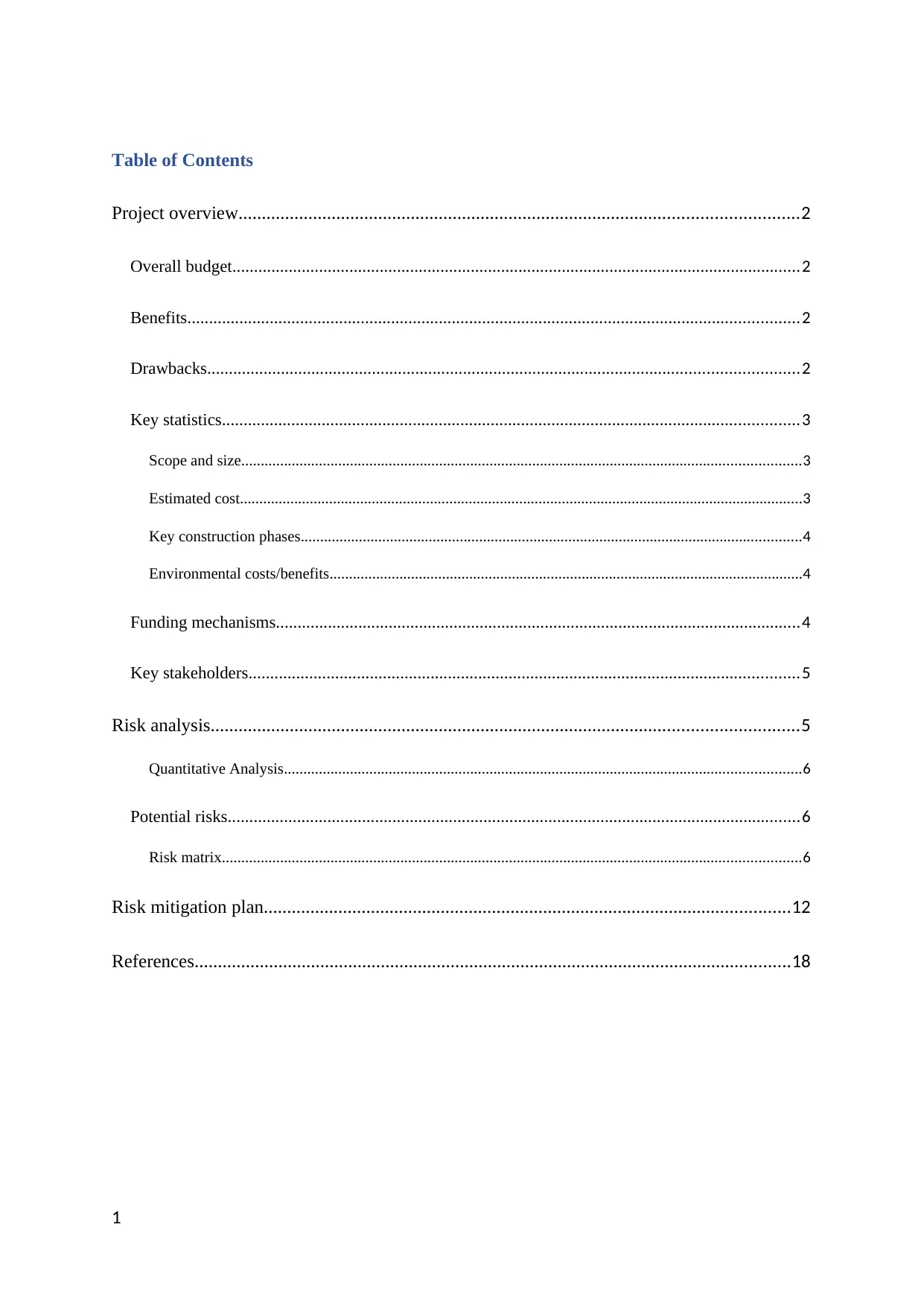
Table of Contents
Project overview........................................................................................................................2
Overall budget...................................................................................................................................2
Benefits.............................................................................................................................................2
Drawbacks........................................................................................................................................2
Key statistics.....................................................................................................................................3
Scope and size................................................................................................................................................3
Estimated cost.................................................................................................................................................3
Key construction phases.................................................................................................................................4
Environmental costs/benefits..........................................................................................................................4
Funding mechanisms.........................................................................................................................4
Key stakeholders...............................................................................................................................5
Risk analysis..............................................................................................................................5
Quantitative Analysis.....................................................................................................................................6
Potential risks....................................................................................................................................6
Risk matrix.....................................................................................................................................................6
Risk mitigation plan.................................................................................................................12
References................................................................................................................................18
1
Project overview........................................................................................................................2
Overall budget...................................................................................................................................2
Benefits.............................................................................................................................................2
Drawbacks........................................................................................................................................2
Key statistics.....................................................................................................................................3
Scope and size................................................................................................................................................3
Estimated cost.................................................................................................................................................3
Key construction phases.................................................................................................................................4
Environmental costs/benefits..........................................................................................................................4
Funding mechanisms.........................................................................................................................4
Key stakeholders...............................................................................................................................5
Risk analysis..............................................................................................................................5
Quantitative Analysis.....................................................................................................................................6
Potential risks....................................................................................................................................6
Risk matrix.....................................................................................................................................................6
Risk mitigation plan.................................................................................................................12
References................................................................................................................................18
1
Paraphrase This Document
Need a fresh take? Get an instant paraphrase of this document with our AI Paraphraser
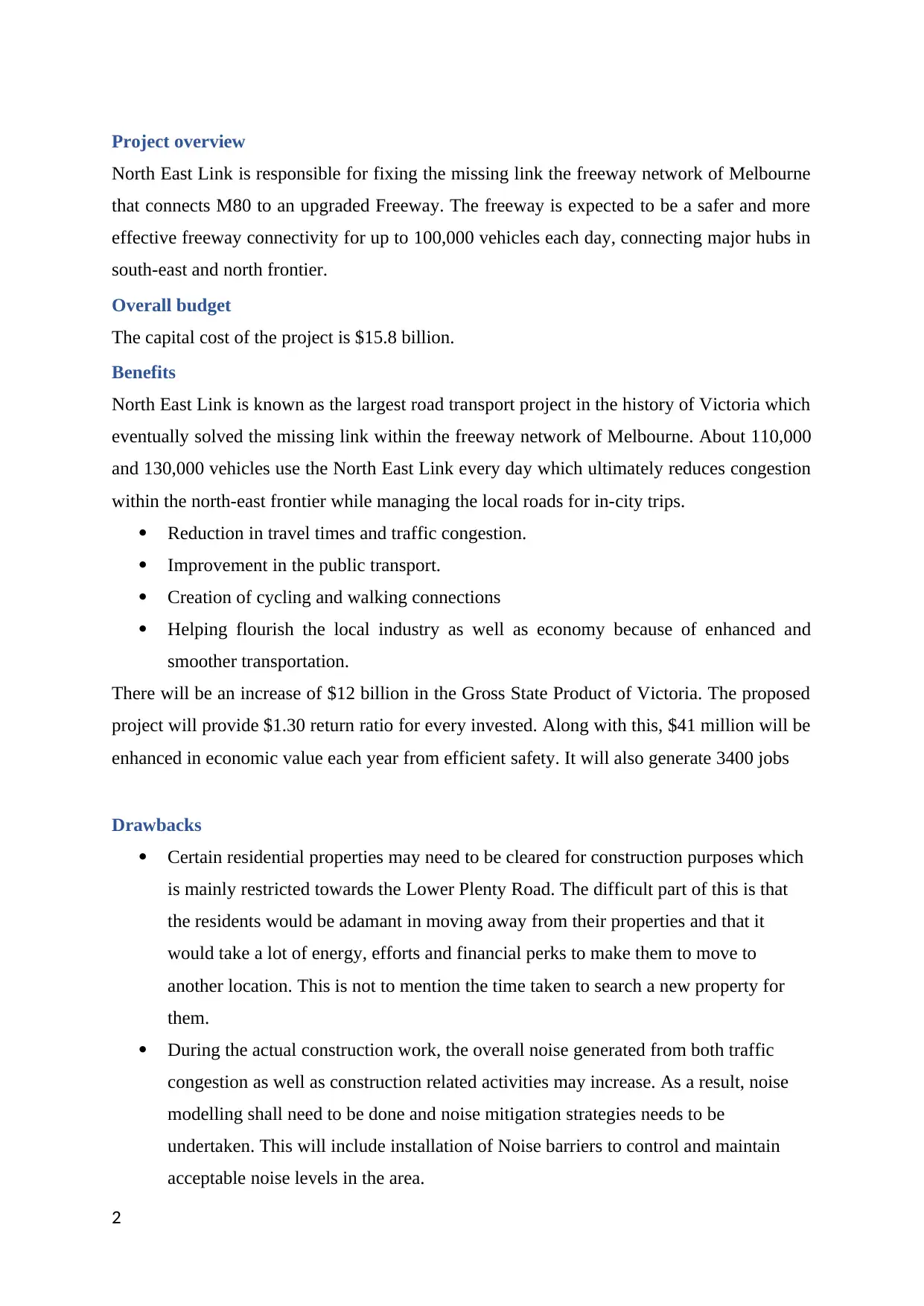
Project overview
North East Link is responsible for fixing the missing link the freeway network of Melbourne
that connects M80 to an upgraded Freeway. The freeway is expected to be a safer and more
effective freeway connectivity for up to 100,000 vehicles each day, connecting major hubs in
south-east and north frontier.
Overall budget
The capital cost of the project is $15.8 billion.
Benefits
North East Link is known as the largest road transport project in the history of Victoria which
eventually solved the missing link within the freeway network of Melbourne. About 110,000
and 130,000 vehicles use the North East Link every day which ultimately reduces congestion
within the north-east frontier while managing the local roads for in-city trips.
Reduction in travel times and traffic congestion.
Improvement in the public transport.
Creation of cycling and walking connections
Helping flourish the local industry as well as economy because of enhanced and
smoother transportation.
There will be an increase of $12 billion in the Gross State Product of Victoria. The proposed
project will provide $1.30 return ratio for every invested. Along with this, $41 million will be
enhanced in economic value each year from efficient safety. It will also generate 3400 jobs
Drawbacks
Certain residential properties may need to be cleared for construction purposes which
is mainly restricted towards the Lower Plenty Road. The difficult part of this is that
the residents would be adamant in moving away from their properties and that it
would take a lot of energy, efforts and financial perks to make them to move to
another location. This is not to mention the time taken to search a new property for
them.
During the actual construction work, the overall noise generated from both traffic
congestion as well as construction related activities may increase. As a result, noise
modelling shall need to be done and noise mitigation strategies needs to be
undertaken. This will include installation of Noise barriers to control and maintain
acceptable noise levels in the area.
2
North East Link is responsible for fixing the missing link the freeway network of Melbourne
that connects M80 to an upgraded Freeway. The freeway is expected to be a safer and more
effective freeway connectivity for up to 100,000 vehicles each day, connecting major hubs in
south-east and north frontier.
Overall budget
The capital cost of the project is $15.8 billion.
Benefits
North East Link is known as the largest road transport project in the history of Victoria which
eventually solved the missing link within the freeway network of Melbourne. About 110,000
and 130,000 vehicles use the North East Link every day which ultimately reduces congestion
within the north-east frontier while managing the local roads for in-city trips.
Reduction in travel times and traffic congestion.
Improvement in the public transport.
Creation of cycling and walking connections
Helping flourish the local industry as well as economy because of enhanced and
smoother transportation.
There will be an increase of $12 billion in the Gross State Product of Victoria. The proposed
project will provide $1.30 return ratio for every invested. Along with this, $41 million will be
enhanced in economic value each year from efficient safety. It will also generate 3400 jobs
Drawbacks
Certain residential properties may need to be cleared for construction purposes which
is mainly restricted towards the Lower Plenty Road. The difficult part of this is that
the residents would be adamant in moving away from their properties and that it
would take a lot of energy, efforts and financial perks to make them to move to
another location. This is not to mention the time taken to search a new property for
them.
During the actual construction work, the overall noise generated from both traffic
congestion as well as construction related activities may increase. As a result, noise
modelling shall need to be done and noise mitigation strategies needs to be
undertaken. This will include installation of Noise barriers to control and maintain
acceptable noise levels in the area.
2
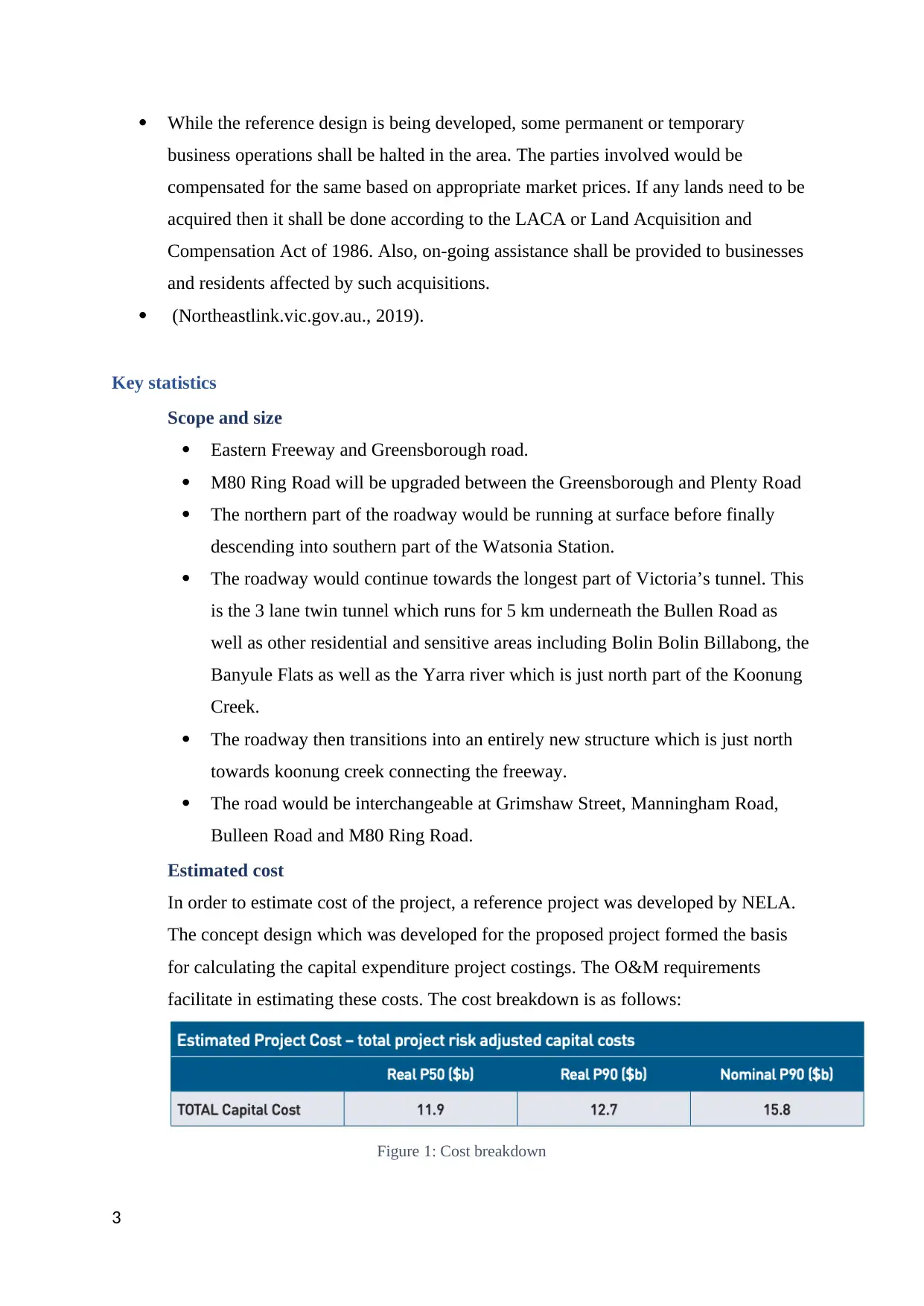
While the reference design is being developed, some permanent or temporary
business operations shall be halted in the area. The parties involved would be
compensated for the same based on appropriate market prices. If any lands need to be
acquired then it shall be done according to the LACA or Land Acquisition and
Compensation Act of 1986. Also, on-going assistance shall be provided to businesses
and residents affected by such acquisitions.
(Northeastlink.vic.gov.au., 2019).
Key statistics
Scope and size
Eastern Freeway and Greensborough road.
M80 Ring Road will be upgraded between the Greensborough and Plenty Road
The northern part of the roadway would be running at surface before finally
descending into southern part of the Watsonia Station.
The roadway would continue towards the longest part of Victoria’s tunnel. This
is the 3 lane twin tunnel which runs for 5 km underneath the Bullen Road as
well as other residential and sensitive areas including Bolin Bolin Billabong, the
Banyule Flats as well as the Yarra river which is just north part of the Koonung
Creek.
The roadway then transitions into an entirely new structure which is just north
towards koonung creek connecting the freeway.
The road would be interchangeable at Grimshaw Street, Manningham Road,
Bulleen Road and M80 Ring Road.
Estimated cost
In order to estimate cost of the project, a reference project was developed by NELA.
The concept design which was developed for the proposed project formed the basis
for calculating the capital expenditure project costings. The O&M requirements
facilitate in estimating these costs. The cost breakdown is as follows:
Figure 1: Cost breakdown
3
business operations shall be halted in the area. The parties involved would be
compensated for the same based on appropriate market prices. If any lands need to be
acquired then it shall be done according to the LACA or Land Acquisition and
Compensation Act of 1986. Also, on-going assistance shall be provided to businesses
and residents affected by such acquisitions.
(Northeastlink.vic.gov.au., 2019).
Key statistics
Scope and size
Eastern Freeway and Greensborough road.
M80 Ring Road will be upgraded between the Greensborough and Plenty Road
The northern part of the roadway would be running at surface before finally
descending into southern part of the Watsonia Station.
The roadway would continue towards the longest part of Victoria’s tunnel. This
is the 3 lane twin tunnel which runs for 5 km underneath the Bullen Road as
well as other residential and sensitive areas including Bolin Bolin Billabong, the
Banyule Flats as well as the Yarra river which is just north part of the Koonung
Creek.
The roadway then transitions into an entirely new structure which is just north
towards koonung creek connecting the freeway.
The road would be interchangeable at Grimshaw Street, Manningham Road,
Bulleen Road and M80 Ring Road.
Estimated cost
In order to estimate cost of the project, a reference project was developed by NELA.
The concept design which was developed for the proposed project formed the basis
for calculating the capital expenditure project costings. The O&M requirements
facilitate in estimating these costs. The cost breakdown is as follows:
Figure 1: Cost breakdown
3
⊘ This is a preview!⊘
Do you want full access?
Subscribe today to unlock all pages.

Trusted by 1+ million students worldwide
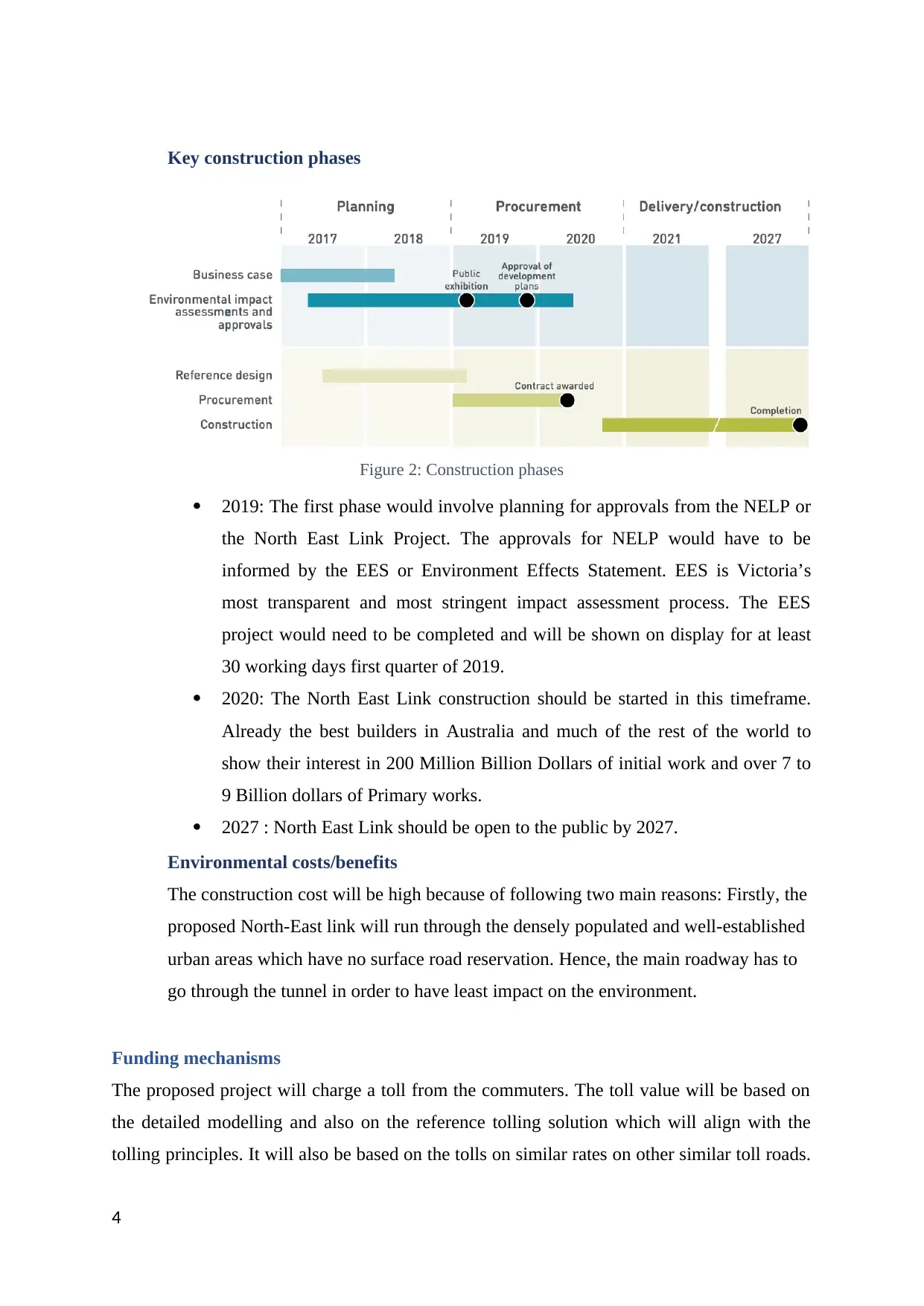
Key construction phases
Figure 2: Construction phases
2019: The first phase would involve planning for approvals from the NELP or
the North East Link Project. The approvals for NELP would have to be
informed by the EES or Environment Effects Statement. EES is Victoria’s
most transparent and most stringent impact assessment process. The EES
project would need to be completed and will be shown on display for at least
30 working days first quarter of 2019.
2020: The North East Link construction should be started in this timeframe.
Already the best builders in Australia and much of the rest of the world to
show their interest in 200 Million Billion Dollars of initial work and over 7 to
9 Billion dollars of Primary works.
2027 : North East Link should be open to the public by 2027.
Environmental costs/benefits
The construction cost will be high because of following two main reasons: Firstly, the
proposed North-East link will run through the densely populated and well-established
urban areas which have no surface road reservation. Hence, the main roadway has to
go through the tunnel in order to have least impact on the environment.
Funding mechanisms
The proposed project will charge a toll from the commuters. The toll value will be based on
the detailed modelling and also on the reference tolling solution which will align with the
tolling principles. It will also be based on the tolls on similar rates on other similar toll roads.
4
Figure 2: Construction phases
2019: The first phase would involve planning for approvals from the NELP or
the North East Link Project. The approvals for NELP would have to be
informed by the EES or Environment Effects Statement. EES is Victoria’s
most transparent and most stringent impact assessment process. The EES
project would need to be completed and will be shown on display for at least
30 working days first quarter of 2019.
2020: The North East Link construction should be started in this timeframe.
Already the best builders in Australia and much of the rest of the world to
show their interest in 200 Million Billion Dollars of initial work and over 7 to
9 Billion dollars of Primary works.
2027 : North East Link should be open to the public by 2027.
Environmental costs/benefits
The construction cost will be high because of following two main reasons: Firstly, the
proposed North-East link will run through the densely populated and well-established
urban areas which have no surface road reservation. Hence, the main roadway has to
go through the tunnel in order to have least impact on the environment.
Funding mechanisms
The proposed project will charge a toll from the commuters. The toll value will be based on
the detailed modelling and also on the reference tolling solution which will align with the
tolling principles. It will also be based on the tolls on similar rates on other similar toll roads.
4
Paraphrase This Document
Need a fresh take? Get an instant paraphrase of this document with our AI Paraphraser
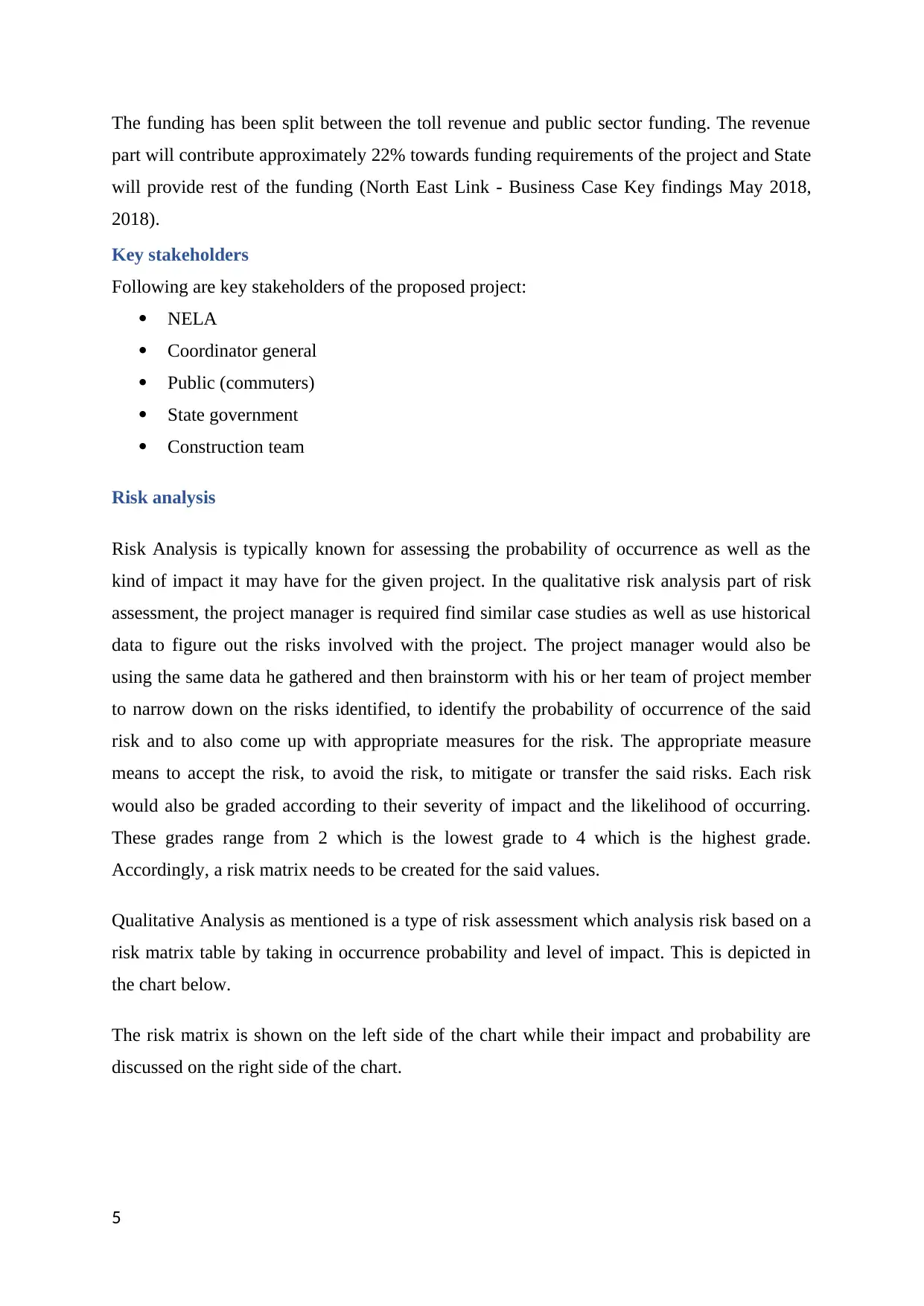
The funding has been split between the toll revenue and public sector funding. The revenue
part will contribute approximately 22% towards funding requirements of the project and State
will provide rest of the funding (North East Link - Business Case Key findings May 2018,
2018).
Key stakeholders
Following are key stakeholders of the proposed project:
NELA
Coordinator general
Public (commuters)
State government
Construction team
Risk analysis
Risk Analysis is typically known for assessing the probability of occurrence as well as the
kind of impact it may have for the given project. In the qualitative risk analysis part of risk
assessment, the project manager is required find similar case studies as well as use historical
data to figure out the risks involved with the project. The project manager would also be
using the same data he gathered and then brainstorm with his or her team of project member
to narrow down on the risks identified, to identify the probability of occurrence of the said
risk and to also come up with appropriate measures for the risk. The appropriate measure
means to accept the risk, to avoid the risk, to mitigate or transfer the said risks. Each risk
would also be graded according to their severity of impact and the likelihood of occurring.
These grades range from 2 which is the lowest grade to 4 which is the highest grade.
Accordingly, a risk matrix needs to be created for the said values.
Qualitative Analysis as mentioned is a type of risk assessment which analysis risk based on a
risk matrix table by taking in occurrence probability and level of impact. This is depicted in
the chart below.
The risk matrix is shown on the left side of the chart while their impact and probability are
discussed on the right side of the chart.
5
part will contribute approximately 22% towards funding requirements of the project and State
will provide rest of the funding (North East Link - Business Case Key findings May 2018,
2018).
Key stakeholders
Following are key stakeholders of the proposed project:
NELA
Coordinator general
Public (commuters)
State government
Construction team
Risk analysis
Risk Analysis is typically known for assessing the probability of occurrence as well as the
kind of impact it may have for the given project. In the qualitative risk analysis part of risk
assessment, the project manager is required find similar case studies as well as use historical
data to figure out the risks involved with the project. The project manager would also be
using the same data he gathered and then brainstorm with his or her team of project member
to narrow down on the risks identified, to identify the probability of occurrence of the said
risk and to also come up with appropriate measures for the risk. The appropriate measure
means to accept the risk, to avoid the risk, to mitigate or transfer the said risks. Each risk
would also be graded according to their severity of impact and the likelihood of occurring.
These grades range from 2 which is the lowest grade to 4 which is the highest grade.
Accordingly, a risk matrix needs to be created for the said values.
Qualitative Analysis as mentioned is a type of risk assessment which analysis risk based on a
risk matrix table by taking in occurrence probability and level of impact. This is depicted in
the chart below.
The risk matrix is shown on the left side of the chart while their impact and probability are
discussed on the right side of the chart.
5
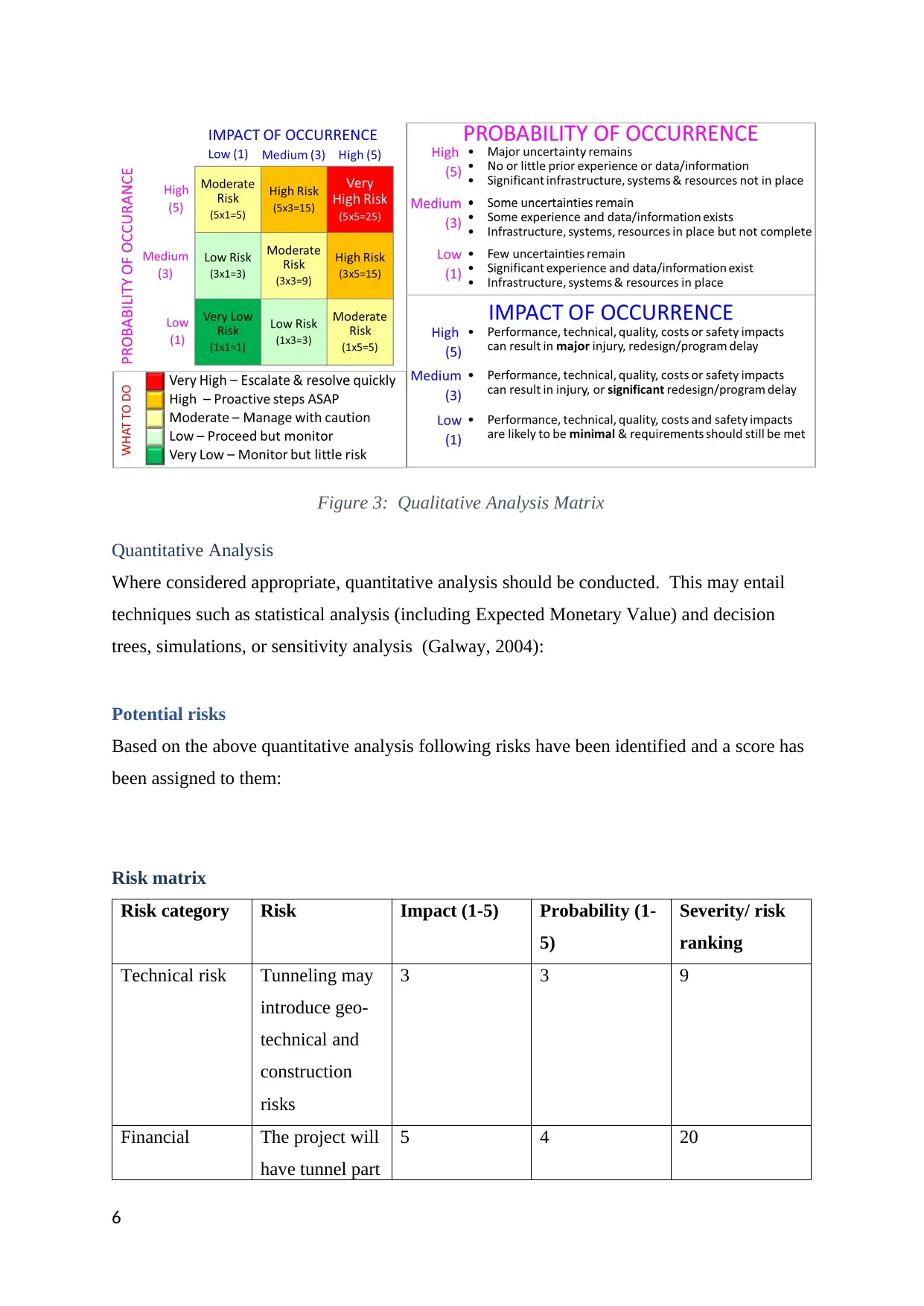
Figure 3: Qualitative Analysis Matrix
Quantitative Analysis
Where considered appropriate, quantitative analysis should be conducted. This may entail
techniques such as statistical analysis (including Expected Monetary Value) and decision
trees, simulations, or sensitivity analysis (Galway, 2004):
Potential risks
Based on the above quantitative analysis following risks have been identified and a score has
been assigned to them:
Risk matrix
Risk category Risk Impact (1-5) Probability (1-
5)
Severity/ risk
ranking
Technical risk Tunneling may
introduce geo-
technical and
construction
risks
3 3 9
Financial The project will
have tunnel part
5 4 20
6
Quantitative Analysis
Where considered appropriate, quantitative analysis should be conducted. This may entail
techniques such as statistical analysis (including Expected Monetary Value) and decision
trees, simulations, or sensitivity analysis (Galway, 2004):
Potential risks
Based on the above quantitative analysis following risks have been identified and a score has
been assigned to them:
Risk matrix
Risk category Risk Impact (1-5) Probability (1-
5)
Severity/ risk
ranking
Technical risk Tunneling may
introduce geo-
technical and
construction
risks
3 3 9
Financial The project will
have tunnel part
5 4 20
6
⊘ This is a preview!⊘
Do you want full access?
Subscribe today to unlock all pages.

Trusted by 1+ million students worldwide
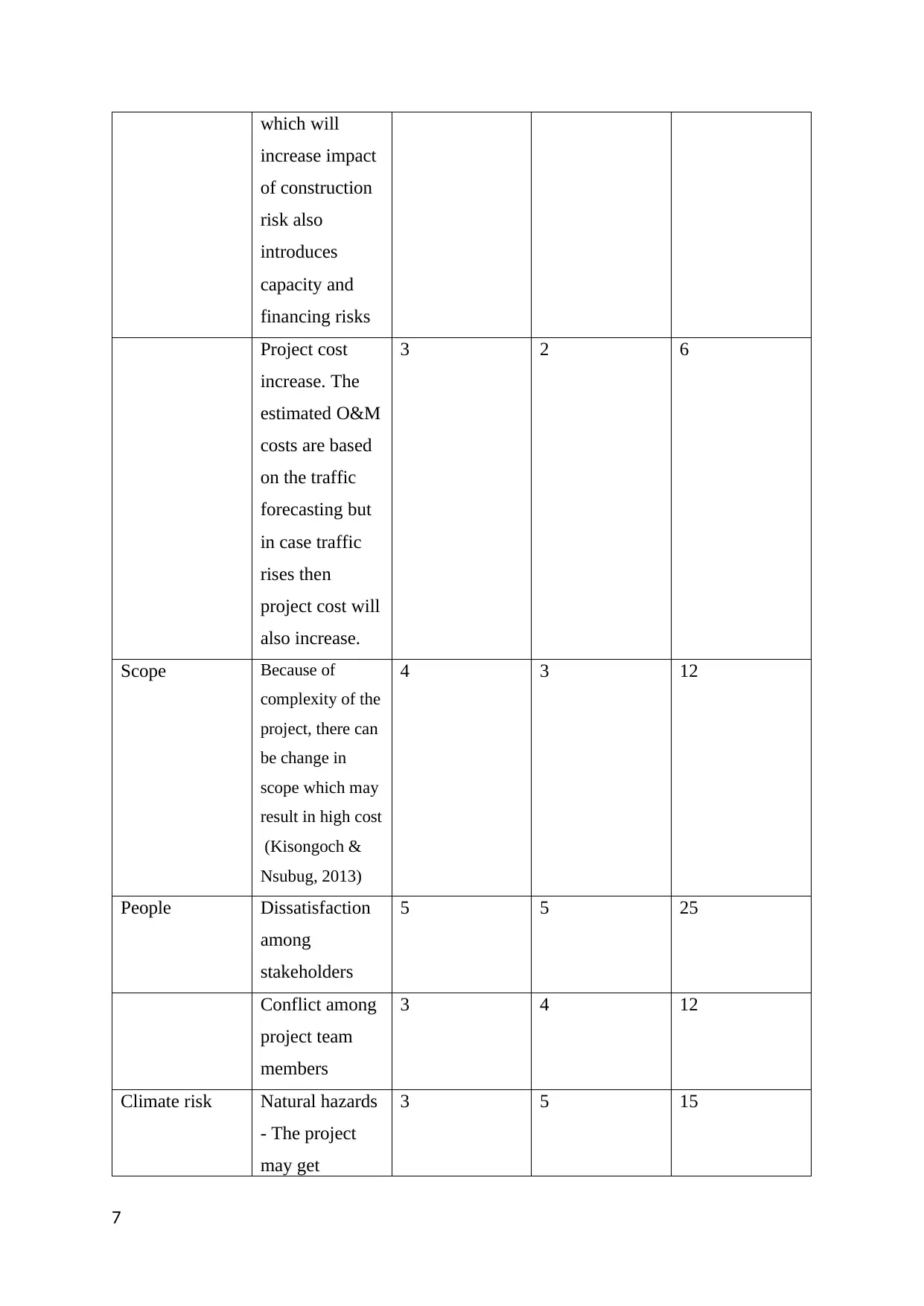
which will
increase impact
of construction
risk also
introduces
capacity and
financing risks
Project cost
increase. The
estimated O&M
costs are based
on the traffic
forecasting but
in case traffic
rises then
project cost will
also increase.
3 2 6
Scope Because of
complexity of the
project, there can
be change in
scope which may
result in high cost
(Kisongoch &
Nsubug, 2013)
4 3 12
People Dissatisfaction
among
stakeholders
5 5 25
Conflict among
project team
members
3 4 12
Climate risk Natural hazards
- The project
may get
3 5 15
7
increase impact
of construction
risk also
introduces
capacity and
financing risks
Project cost
increase. The
estimated O&M
costs are based
on the traffic
forecasting but
in case traffic
rises then
project cost will
also increase.
3 2 6
Scope Because of
complexity of the
project, there can
be change in
scope which may
result in high cost
(Kisongoch &
Nsubug, 2013)
4 3 12
People Dissatisfaction
among
stakeholders
5 5 25
Conflict among
project team
members
3 4 12
Climate risk Natural hazards
- The project
may get
3 5 15
7
Paraphrase This Document
Need a fresh take? Get an instant paraphrase of this document with our AI Paraphraser
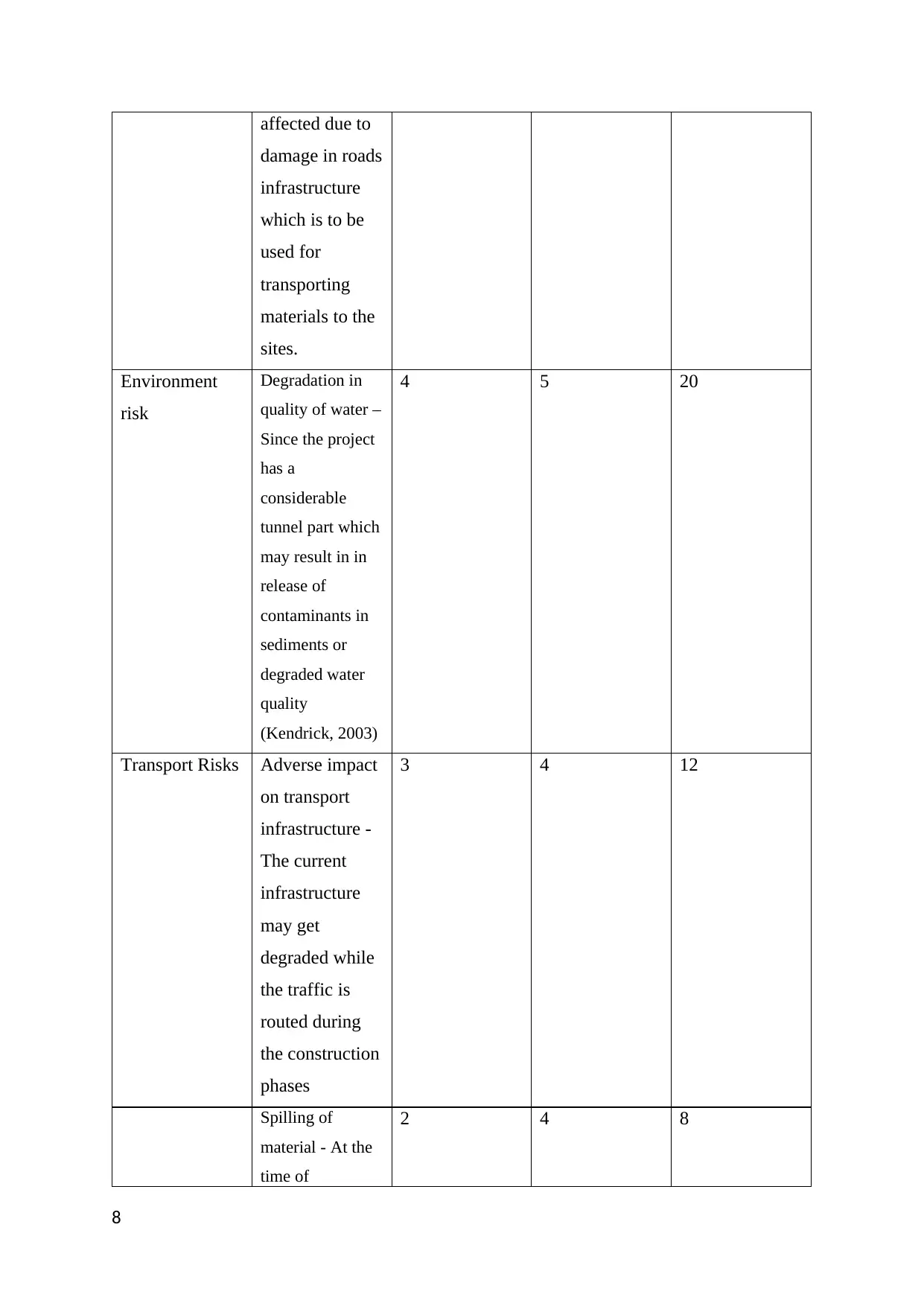
affected due to
damage in roads
infrastructure
which is to be
used for
transporting
materials to the
sites.
Environment
risk
Degradation in
quality of water –
Since the project
has a
considerable
tunnel part which
may result in in
release of
contaminants in
sediments or
degraded water
quality
(Kendrick, 2003)
4 5 20
Transport Risks Adverse impact
on transport
infrastructure -
The current
infrastructure
may get
degraded while
the traffic is
routed during
the construction
phases
3 4 12
Spilling of
material - At the
time of
2 4 8
8
damage in roads
infrastructure
which is to be
used for
transporting
materials to the
sites.
Environment
risk
Degradation in
quality of water –
Since the project
has a
considerable
tunnel part which
may result in in
release of
contaminants in
sediments or
degraded water
quality
(Kendrick, 2003)
4 5 20
Transport Risks Adverse impact
on transport
infrastructure -
The current
infrastructure
may get
degraded while
the traffic is
routed during
the construction
phases
3 4 12
Spilling of
material - At the
time of
2 4 8
8
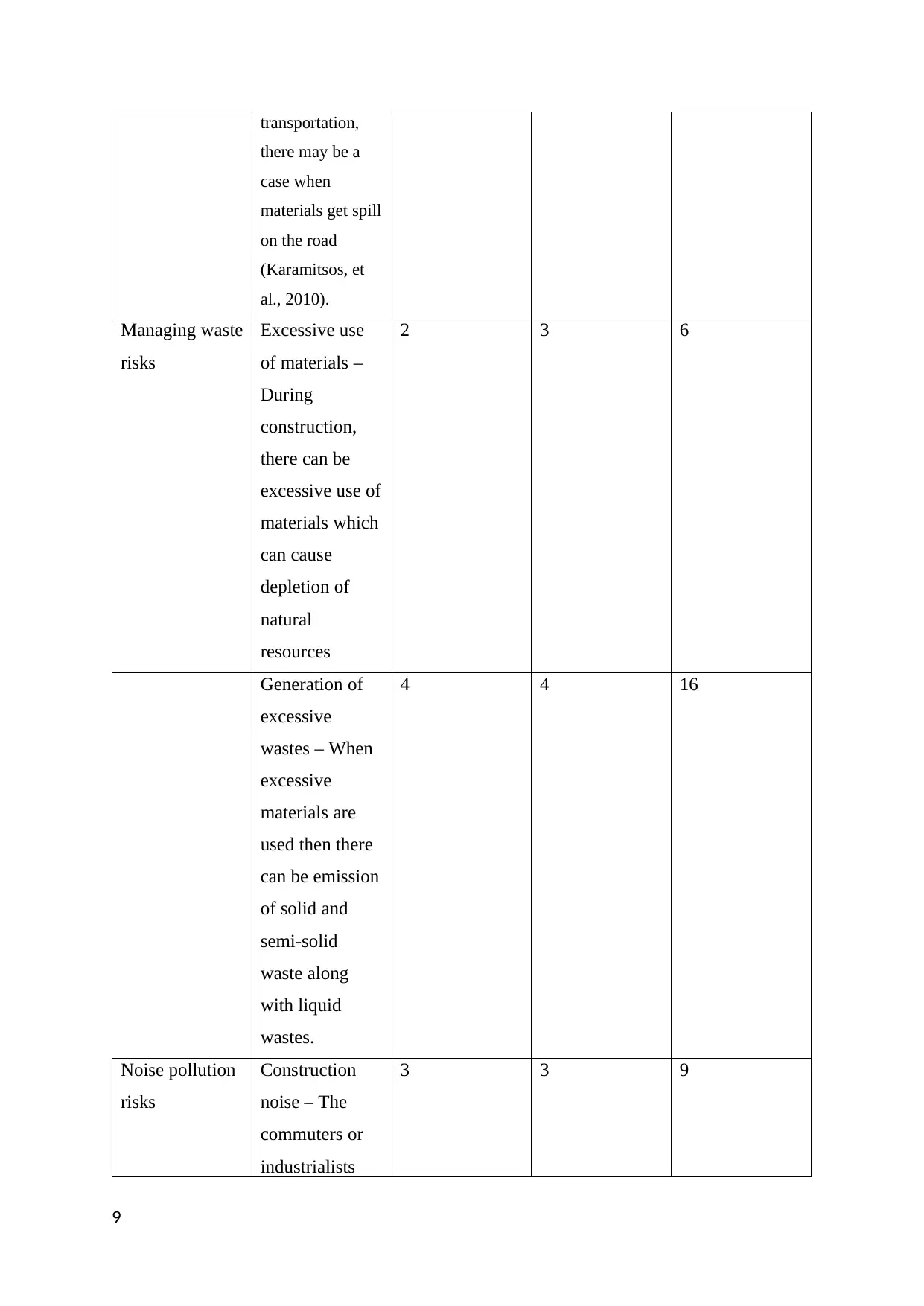
transportation,
there may be a
case when
materials get spill
on the road
(Karamitsos, et
al., 2010).
Managing waste
risks
Excessive use
of materials –
During
construction,
there can be
excessive use of
materials which
can cause
depletion of
natural
resources
2 3 6
Generation of
excessive
wastes – When
excessive
materials are
used then there
can be emission
of solid and
semi-solid
waste along
with liquid
wastes.
4 4 16
Noise pollution
risks
Construction
noise – The
commuters or
industrialists
3 3 9
9
there may be a
case when
materials get spill
on the road
(Karamitsos, et
al., 2010).
Managing waste
risks
Excessive use
of materials –
During
construction,
there can be
excessive use of
materials which
can cause
depletion of
natural
resources
2 3 6
Generation of
excessive
wastes – When
excessive
materials are
used then there
can be emission
of solid and
semi-solid
waste along
with liquid
wastes.
4 4 16
Noise pollution
risks
Construction
noise – The
commuters or
industrialists
3 3 9
9
⊘ This is a preview!⊘
Do you want full access?
Subscribe today to unlock all pages.

Trusted by 1+ million students worldwide
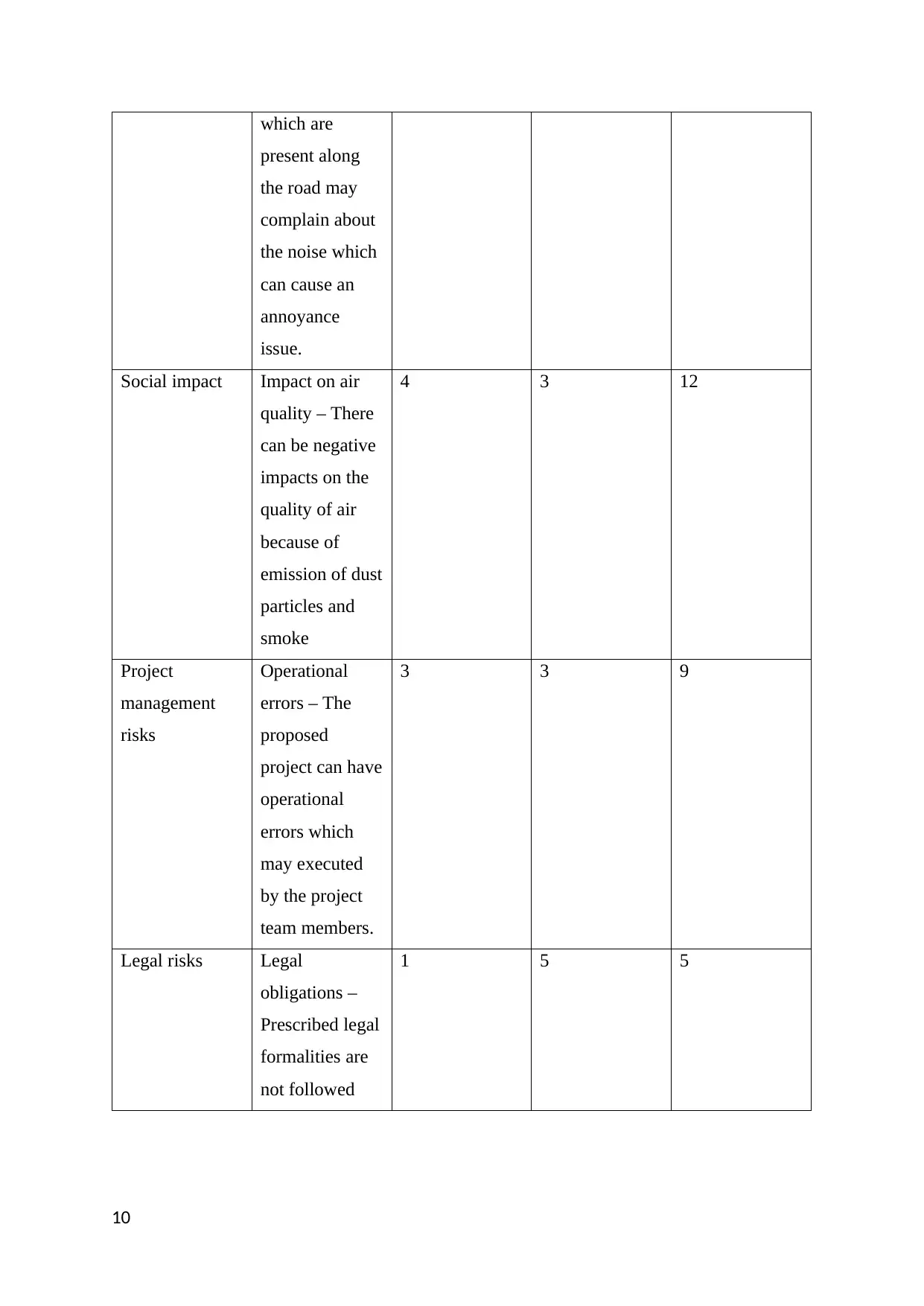
which are
present along
the road may
complain about
the noise which
can cause an
annoyance
issue.
Social impact Impact on air
quality – There
can be negative
impacts on the
quality of air
because of
emission of dust
particles and
smoke
4 3 12
Project
management
risks
Operational
errors – The
proposed
project can have
operational
errors which
may executed
by the project
team members.
3 3 9
Legal risks Legal
obligations –
Prescribed legal
formalities are
not followed
1 5 5
10
present along
the road may
complain about
the noise which
can cause an
annoyance
issue.
Social impact Impact on air
quality – There
can be negative
impacts on the
quality of air
because of
emission of dust
particles and
smoke
4 3 12
Project
management
risks
Operational
errors – The
proposed
project can have
operational
errors which
may executed
by the project
team members.
3 3 9
Legal risks Legal
obligations –
Prescribed legal
formalities are
not followed
1 5 5
10
Paraphrase This Document
Need a fresh take? Get an instant paraphrase of this document with our AI Paraphraser
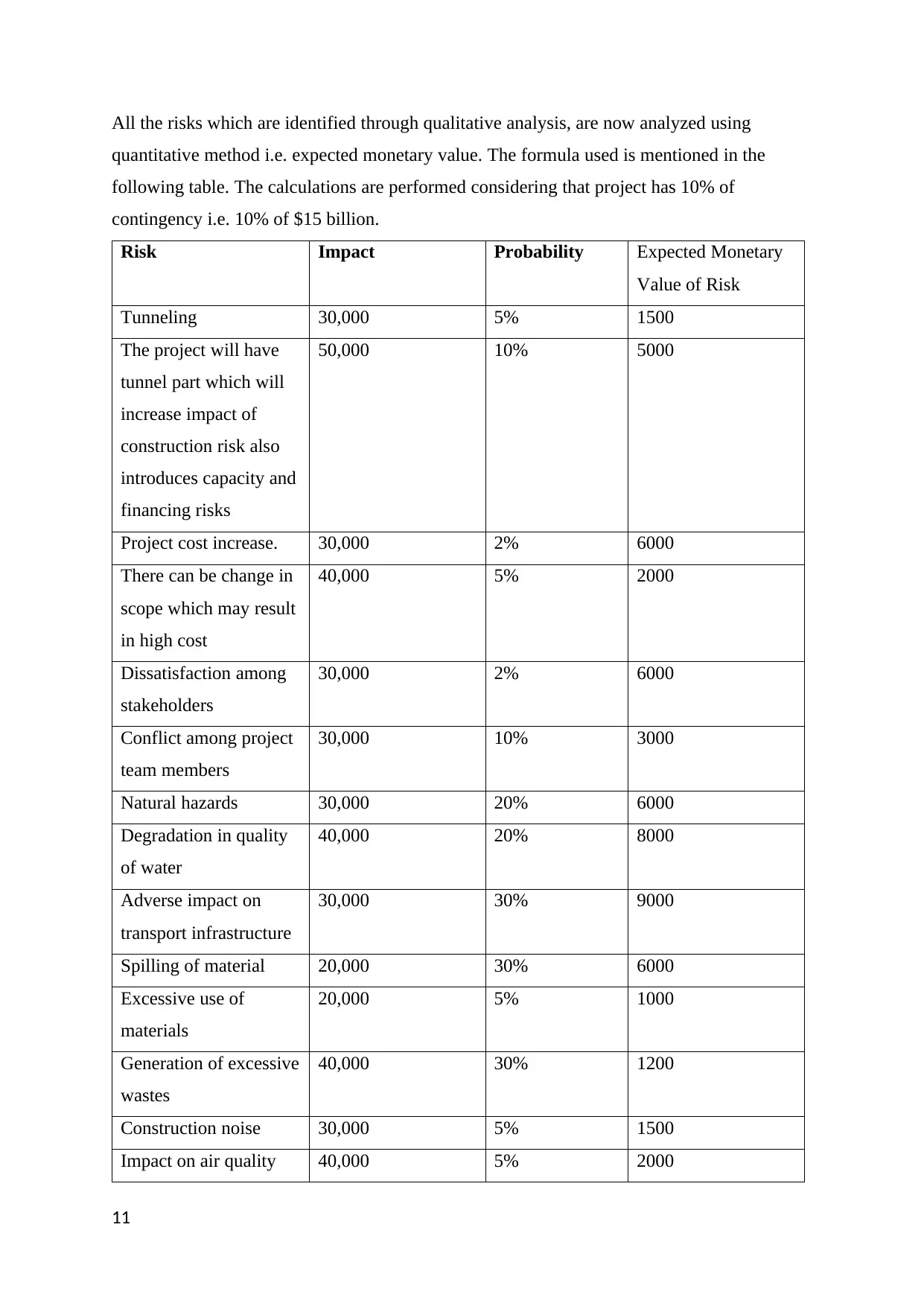
All the risks which are identified through qualitative analysis, are now analyzed using
quantitative method i.e. expected monetary value. The formula used is mentioned in the
following table. The calculations are performed considering that project has 10% of
contingency i.e. 10% of $15 billion.
Risk Impact Probability Expected Monetary
Value of Risk
Tunneling 30,000 5% 1500
The project will have
tunnel part which will
increase impact of
construction risk also
introduces capacity and
financing risks
50,000 10% 5000
Project cost increase. 30,000 2% 6000
There can be change in
scope which may result
in high cost
40,000 5% 2000
Dissatisfaction among
stakeholders
30,000 2% 6000
Conflict among project
team members
30,000 10% 3000
Natural hazards 30,000 20% 6000
Degradation in quality
of water
40,000 20% 8000
Adverse impact on
transport infrastructure
30,000 30% 9000
Spilling of material 20,000 30% 6000
Excessive use of
materials
20,000 5% 1000
Generation of excessive
wastes
40,000 30% 1200
Construction noise 30,000 5% 1500
Impact on air quality 40,000 5% 2000
11
quantitative method i.e. expected monetary value. The formula used is mentioned in the
following table. The calculations are performed considering that project has 10% of
contingency i.e. 10% of $15 billion.
Risk Impact Probability Expected Monetary
Value of Risk
Tunneling 30,000 5% 1500
The project will have
tunnel part which will
increase impact of
construction risk also
introduces capacity and
financing risks
50,000 10% 5000
Project cost increase. 30,000 2% 6000
There can be change in
scope which may result
in high cost
40,000 5% 2000
Dissatisfaction among
stakeholders
30,000 2% 6000
Conflict among project
team members
30,000 10% 3000
Natural hazards 30,000 20% 6000
Degradation in quality
of water
40,000 20% 8000
Adverse impact on
transport infrastructure
30,000 30% 9000
Spilling of material 20,000 30% 6000
Excessive use of
materials
20,000 5% 1000
Generation of excessive
wastes
40,000 30% 1200
Construction noise 30,000 5% 1500
Impact on air quality 40,000 5% 2000
11
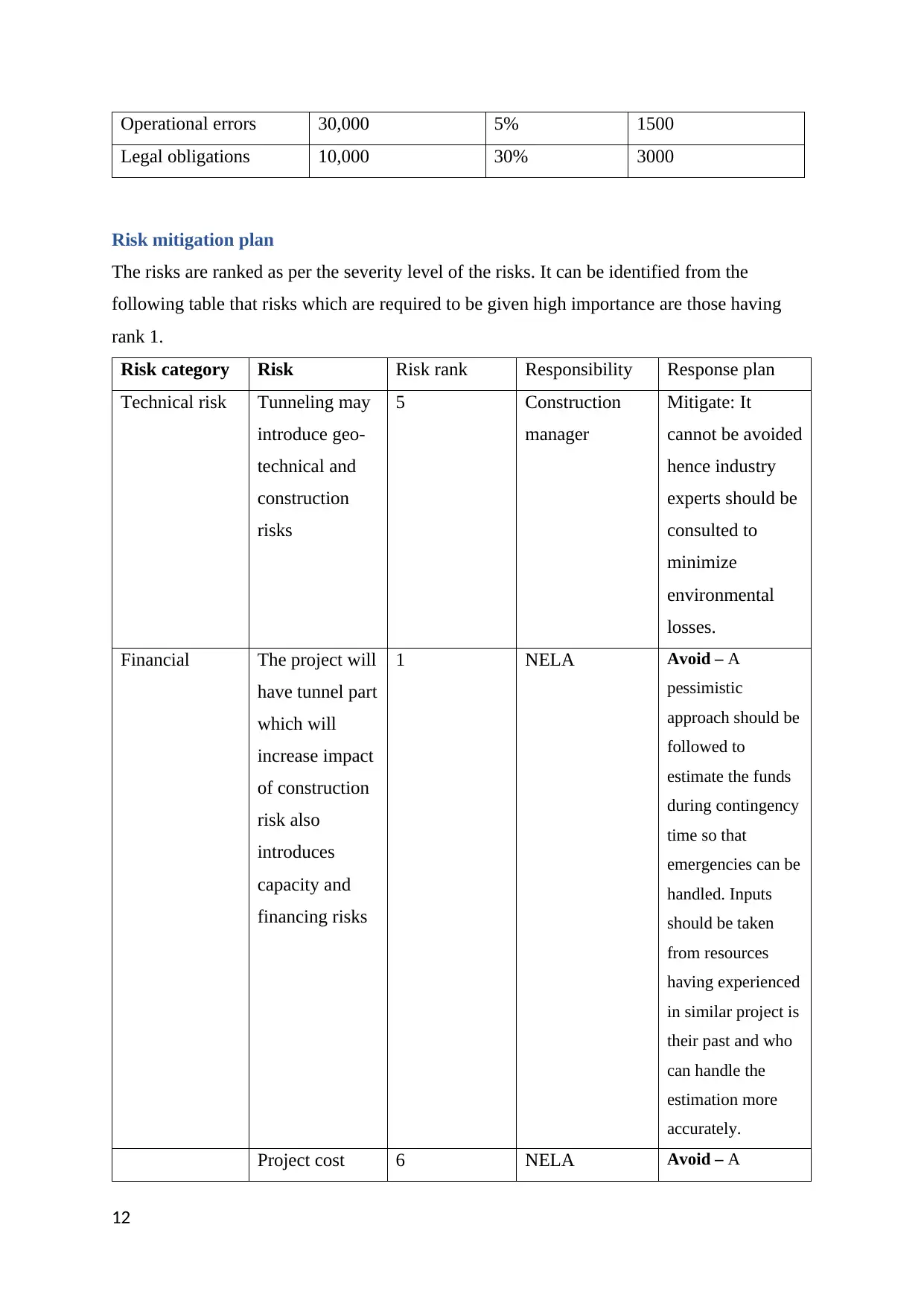
Operational errors 30,000 5% 1500
Legal obligations 10,000 30% 3000
Risk mitigation plan
The risks are ranked as per the severity level of the risks. It can be identified from the
following table that risks which are required to be given high importance are those having
rank 1.
Risk category Risk Risk rank Responsibility Response plan
Technical risk Tunneling may
introduce geo-
technical and
construction
risks
5 Construction
manager
Mitigate: It
cannot be avoided
hence industry
experts should be
consulted to
minimize
environmental
losses.
Financial The project will
have tunnel part
which will
increase impact
of construction
risk also
introduces
capacity and
financing risks
1 NELA Avoid – A
pessimistic
approach should be
followed to
estimate the funds
during contingency
time so that
emergencies can be
handled. Inputs
should be taken
from resources
having experienced
in similar project is
their past and who
can handle the
estimation more
accurately.
Project cost 6 NELA Avoid – A
12
Legal obligations 10,000 30% 3000
Risk mitigation plan
The risks are ranked as per the severity level of the risks. It can be identified from the
following table that risks which are required to be given high importance are those having
rank 1.
Risk category Risk Risk rank Responsibility Response plan
Technical risk Tunneling may
introduce geo-
technical and
construction
risks
5 Construction
manager
Mitigate: It
cannot be avoided
hence industry
experts should be
consulted to
minimize
environmental
losses.
Financial The project will
have tunnel part
which will
increase impact
of construction
risk also
introduces
capacity and
financing risks
1 NELA Avoid – A
pessimistic
approach should be
followed to
estimate the funds
during contingency
time so that
emergencies can be
handled. Inputs
should be taken
from resources
having experienced
in similar project is
their past and who
can handle the
estimation more
accurately.
Project cost 6 NELA Avoid – A
12
⊘ This is a preview!⊘
Do you want full access?
Subscribe today to unlock all pages.

Trusted by 1+ million students worldwide
1 out of 18
Related Documents
Your All-in-One AI-Powered Toolkit for Academic Success.
+13062052269
info@desklib.com
Available 24*7 on WhatsApp / Email
![[object Object]](/_next/static/media/star-bottom.7253800d.svg)
Unlock your academic potential
Copyright © 2020–2025 A2Z Services. All Rights Reserved. Developed and managed by ZUCOL.





